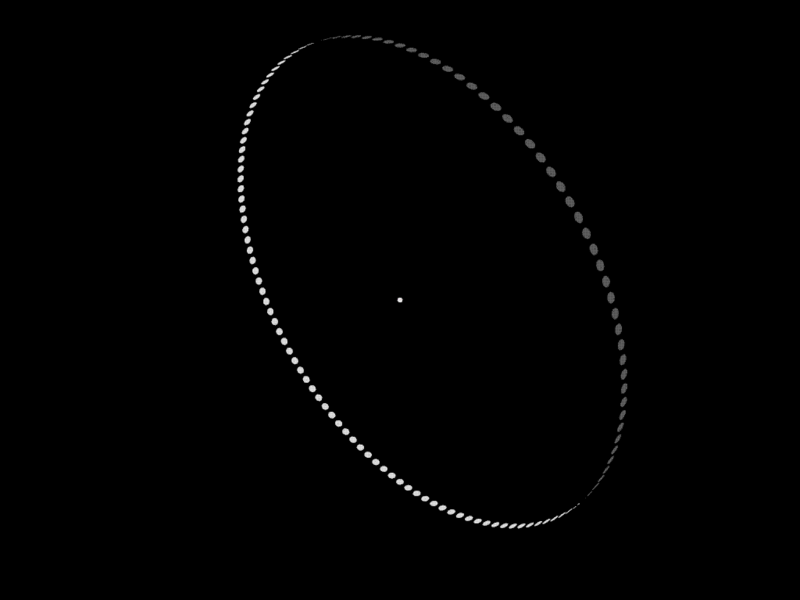Some day in the far future, it’s possible our descendants will kick it up a notch and wrap the entire Sun in a massive solar-collecting shell known as a Dyson Sphere. It’s also possible that some advanced alien civilisations have already gone this route, which is why some SETI folks are on the lookout for these hypothetical objects. But a new study proposes that aliens are more likely to build megastructures around pulsars than stars — and importantly, we should be able to detect these objects from Earth using current technology.
Image: NASA
When Freeman Dyson came up with his mind-altering idea back in 1959, he wasn’t imagining an energy solution for future humans. Instead, he was thinking about aliens, and the kinds of things we should be looking for to finally prove they actually exist. Today, the search for alien megastructures is referred to as Dysonian SETI, and we haven’t found anything yet (though we’ve had some false signals).
Conceptually, Dyson’s hypothetical sphere makes a lot of sense, particularly for advanced civilisations with a huge appetite for energy. By constructing a thin spherical shell around its sun, a civilisation could capture oodles of solar energy that would otherwise bleed uselessly into space.
Graduating to a Type 2 Kardashev civilisation sounds all good and well, but constructing — and maintaining — a megastructure of this scale won’t be easy. The shell itself would be located around one AU from the host star (that’s the average distance the Earth orbits the Sun). Consequently, the amount of material required to build a Dyson Sphere would be literally astronomical, and some experts have speculated that, if we were to ever build a Dyson Sphere, we’d have to dismantle Mercury, and possibly even Venus and the Asteroid Belt. Unfortunately, this could disrupt the delicate gravitational balance within the Solar System, leading to downstream consequences such as planet-on-planet collisions. Other challenges exist as well, such as maintaining the shape and position of the shell, and repairing the endless damage wrought to the structure by incoming asteroids and comets.
It’s for these and other reasons that Zaza Osmanov, an astronomer from the Free University of Tbilisi, believes that Dyson Spheres aren’t the way to go. In a paper he published last year in the International Journal of Astrobiology, Osmanov said that Dyson Spheres are “unrealistically massive and cannot be considered seriously”, and that aliens (or future humans for that matter) are more likely to build Dyson Rings — a stripped down version of a Dyson Sphere. What’s more, he said aliens weren’t likely to construct these solar-collecting rings around stars, but pulsars instead. Now, in a follow-up study to this first paper, Osmanov is arguing that we should be able to detect these structures from Earth.
Osmanov’s idea is actually kind of awesome. Pulsars are rapidly rotating neutron stars or white dwarfs that emit a concentrated beam of electromagnetic radiation. From our vantage point on Earth, we can only see pulsars if their beams are pointing directly at us. Pulsars have short and highly regular rotational periods, which is why they blink. (Fun fact: When the first pulsar was discovered in 1967, astronomers thought they had stumbled upon an alien intelligence — they even named it LGM, which stands for Little Green Men.)
According to Osmanov, advanced alien civilisations are likely to exploit this high-power celestial phenomenon. Extending Dyson’s concept to pulsars, he says a ring of solar panels could be constructed around a slowly-rotating pulsar (spinning around about once every half second, so not that slow) at a distance of around 14.5 million km, or roughly one-third of the distance between Mercury and our Sun. He estimates that the Dyson Ring would be exposed to temperatures of around 117C, which would make the object visible to observers on Earth in the infrared (IR) band.
Consequently, and assuming these objects actually exist, Osmanov says we could detect these Dyson rings from Earth using existing telescopes, such as the Very Large Telescope Interferometer (VLTI), the Wide-field Infrared Survey Explorer (WISE), and in future, the James Webb Space Telescope. “The search of infrared rings is quite promising for distances up to [652 lightyears], where one will be able to monitor potentially 64 [known] pulsars by using the IR instruments,” he writes in the study. “Observation of distant pulsars [up to 3262 lightyears]… will significantly increase the total number of potential objects to [around] 1600, but at this moment the UV instruments cannot provide such a level of sensitivity.”

Artist’s impression of a Dyson Ring. (Image: Wikimedia)
“This is pretty cool,” Milan M. Ćirković, an astronomer and astrobiologist at the Astronomical Observatory of Belgrade, told Gizmodo. “I do agree that they are detectable in principle… and this study is worthy of attention just for that. Whether [the construction of Dyson Rings around pulsars] is likely to happen depends on too many issues, including perhaps the most intriguing one, namely what other [kinds]… of megastructures could we expect from a Type 2 civilisation that has capacity and will to build pulsar rings.”
Anders Sandberg, a senior research fellow at Oxford University’s Future of Humanity Institute, likes Osmanov’s idea, but he’s still a big believer in good ol’ fashion Dyson spheres.
“For stars, a Dyson swarm [a variation of the Dyson sphere] can pick up most of the energy because the star shines evenly in all directions,” Sandberg told Gizmodo. “For a pulsar there is not much light, but indeed a big electromagnetic field with a lot of directionality one can capture and use using much smaller rings. Osmanov is right in that this requires less material, but it is not clear why this would matter much. One could build a thin yet energy-collecting Dyson swarm out of a few large asteroids in the solar system. If you have self-replicating [robotic] technology, scale is not a problem, and if you lack it you will struggle to build even a Dyson ring.”
Sandberg also says that Dysonian superstructures don’t have to be located in a star system’s habitable zone, and that we should look for alien megastructures in other regions of space as well.
“But it makes sense to look at pulsars to see if there is something there: They are rare enough to stand out — and it has been suggested that SETI should look near them for this very reason — and they might have accessible energy sources useful in ways normal Dyson swarms aren’t,” he said.
So what the hell are we waiting for? Time for someone with access to an IR-scanning telescope to hone in on on this rather small set of candidate objects. Who knows, the celestial phenomena we once thought were signs of alien intelligence may in fact be home to ET — and possibly a glimpse into our very own future.
